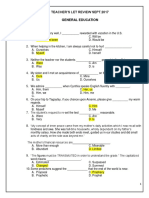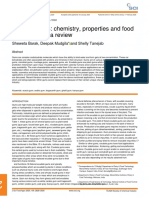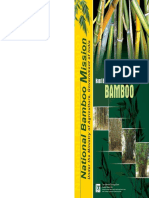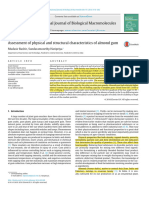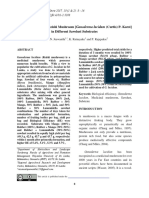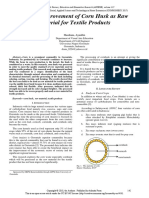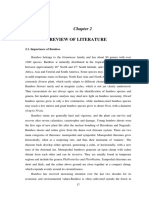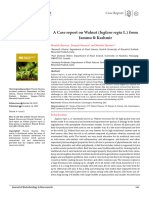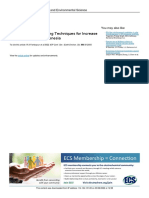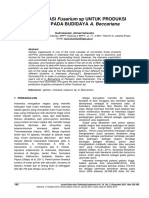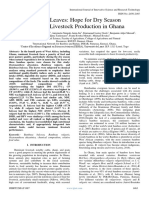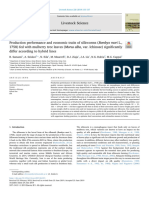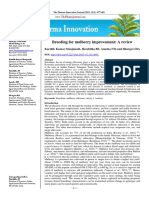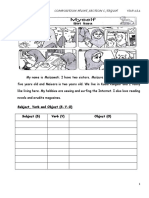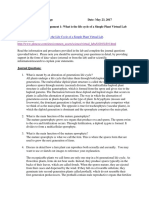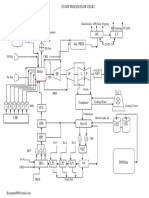Professional Documents
Culture Documents
2013 Gum - Kondagogu - Rview - Published - 1 PDF
Uploaded by
Jaspreet SinghOriginal Description:
Original Title
Copyright
Available Formats
Share this document
Did you find this document useful?
Is this content inappropriate?
Report this DocumentCopyright:
Available Formats
2013 Gum - Kondagogu - Rview - Published - 1 PDF
Uploaded by
Jaspreet SinghCopyright:
Available Formats
The Botanica 62-63: 115-123.
2013
Gum Kondagogu - A Natural Exudate from
Cochlospermum Gossypium
Jaspreet Singh and Balwinder Singh*
Department of Biotechnology, Khalsa College, Amritsar – 143002, Punjab
*E-mail : bbs171@rediffmail.com
Gums and resins are one of the most important non-timber forest products of India and are great
contributors not only to livelihood of forest dependent tribal people but also to nation’s economy.
Gum kondagogu is a tree exudate from Cochlospermum gossypium that belongs to the family
Bixaceae. Nature-wise it is similar to well established gum karaya (Sterculia urens) in its properties.
Gum kondagogu does not have independent identity as an article of commerce. Price-wise,
Kondagogu gum is cheaper than Sterculia gum and used to adulterate the later one. Depending upon
grade and quality, it varies from semi-transparent to pale and then to light brown in colour. It is
water insoluble but swells into gel upon hydration. In last few years, gum kondagogu has assumed
great demand and it is usually exported from India now. The present communication is an approach
for gaining recognition to this indigenous natural product worldwide by giving wide circulation to
the new scientific findings.
Dhawra (Anogeissus latifolia), Gum Salai (Boswellia
Exudate gums are the oldest natural gums being known serrata), Gum Katira (Cochlospermum religiosum),
from 2000 years ago. Gums are natural polymers, Gum Babul (Acacia nilotica/arabica) and Guar Gum
which mainly consists of carbohydrates sometimes (Cyamopsis tetragonoloba) (A Market Survey on
with small amounts of proteins and minerals. Gums and Resins in India, 2006). Food and Agriculture
Increasing demand of natural ingredients over synthetic Organization (FAO), Rome, included the gum from C.
ones immensely contribute to explore and develop new gossypium under karaya gum (S. urens), which is a
plant based materials. Gum kondagogu (Fig. 1), an well studied gum and also recognized as safe for
important non-timber forest product collected by tribals human consumption and included in the list of food
in the state of Andhra Pradesh, is the most recently additives (FAO, 1991).
studied. In 1861 Cleghorn, H.F.C., famous as the father
of scientific forestry in India, in his book ‘The Forests Gums and Resins are ill-defined terms and often
and Gardens of South India’ described Cochlospermum used interchangeably, as both are generally applied to
religiosum (L.) Alston as the new name for the plant exudations that are sticky and elastic in
Cochlospermum gossypium DC. (Fig. 2). In the book, nature. However, according to experts, some plants
A hand book to the flora of Ceylon’ (1931), Bombax yield only gums, others only resins and some both
gossypium L., B. religiosum L., Cochlospermum gums and resins. Resins are typically composed of
balicum Boerl., C. gossypium DC., Maximilianea terpenoids and phenolics that are delivered from
gossypium Kuntze and Wittelsbachia gossypium Mart. intercellular spaces, where as gums are carbohydrates
& Zucc. were mentioned as synonyms to in nature and are polymers of complex
Cochlospermum religiosum (L.) (Alston & Trimen polysaccharides. The process of synthesis of gums is
(1931). termed as ‘Gummosis’ and is common to the plants of
temperate climates. Gums may appear as exudates on
Among the numerous gum producing trees, the the epidermal surfaces of plant body or as internal
priority wise commercially important exudate gums pockets referred as ‘stone gum’ within
from India are; Gum Karaya (Sterculia urens), Gum
THE BOTANICA 115
the tissues. The pathways involved in the biosynthesis substance. It’s another common name is ‘Buttercup
of gums are not yet established. The different views tree’ because its bright-yellow flowers look like large
include that the gums are produced from pectins or sized buttercups.
hemicelluloses or galactans as their raw materials. It is
well known fact that gum synthesis is stimulated as a GEOGRAPHICAL OCCURANCE
result of injury to plant. The apparent function of gum
formation is to seal the plant wounds and prevent Cochlospermum gossypium is a small to medium
microbial infections. The exudate gums are considered sized, deciduous, soft wooded tree (Wealth of India,
as the end products of similar biosynthetic pathways of 1962) occuring throughout India from Garhwal via
plant metabolism. Biosynthesis involves the addition of West Sub-Himalayan tracts to West-Bengal, Bihar,
sugar residues to outer chains of already existing cell Orissa and Deccan peninsula (Prajapati et al., 2003). It
wall polysaccharides, resulting in the formation of is commonly found in the states of Andhra Pradesh,
more complex polymers, which are then exuded as Maharashtra, Madhya Pradesh, Uttar Pradesh and
gums on the surface of plant. Gum kondagogu is Bihar. More than 90% of the gum is produced in four
collected from the fibrous, deeply furrowed bark of tree states: Madhya Pradesh, Chhattisgarh, Andhra
stem. Pradesh and Orissa. Andhra Pradesh alone contributes
more than half of gum production in the country.
SYSTEMATIC POSITION India is the largest producer and exporter of tree gums
(Verbeken et al., 2003).
Kingdom : Plantae
Subkingdom : Tracheobionta COMMERCIAL VALUE
Super division : Spermatophyta Forests of Andhra Pradesh are the richest source of
Division : Magnoliophyta gum kondagogu and home to four million tribal
people, who are economically the most backward
Class : Magnoliopsida
community of the state and are employed in collection
Subclass : Dilleniidae of gum along with other minor forest products. Girijan
Co-operative Corporation (GCC), a state owned
Order : Violales
corporation, since its establishment in 1956,
Family : Bixaceae undertook the guardianship of these tribals in order of
Genus : Cochlospermum improving their socio-economic status. GCC own
monopoly rights over gum collection and sale in
Species : Gossypium domestic markets. It procures gum from the tribal
Synonym : Religiosum areas of Adilabad, Warangal, Khamman,
Mahabubnagar, Kurnool, Vishakapatnam, East-West
Godavari and Chittoor districts. Export to
RECOGNITION international markets is carried out through Tribal Co-
operative Marketing Development Federation
Goverment of India released a postal stamp on Oct 9, (TRIFED), under the Ministry of Tribal affairs, Govt.
1993 (Fig. 3); recognizing Cochlospermum religiosum of India, New Delhi. Table 1 shows the relative
as a flowering plant of national importance. In commercial importance of gum kondagogu. Andhra
Thailand, it is the provincial tree of ‘Nakhon Nayok Pradesh state government exempted the Value Added
Province’. The name ‘religiosum’ is derived from the Tax (VAT) collection on sale of gums. As a result of
fact that the flowers are used as temple offerings. Plant the collaborative measures applied by State
is commonly known as ‘Silk-Cotton tree’ because the Government and other agencies, the demand as well
capsules containing the seeds have a fluffy cotton-like as price of gum has grown rapidly (Table 2).
116 THE BOTANICA
Table - 1 : Production and value of gum kondagogu against Table - 2 : Selling price of gum kondagogu over the period
total minor forest produce by GCC. from 1993-2005.
Year Price per Kg. (Rs.)
Year Quantity Value Total minor
(Qtls.) (Rs. Lakhs) forest Grade I Grade II Grade III
production
1993-94 50.00 35.00 22.00
(Rs. Lakhs)
2000-01 100.00 60.00 42.00
2000-01 1160.00 86.82 1940.29
2004-05 120.00 80.00 60.00
2001-02 1158.85 85.40 1487.96
Increase over 70.00 45.00 38.00
2002-03 1297.00 101.90 1660.82
1993-94
2003-04 1244.00 100.81 1365.44 Source : GCC, Visakhapatnam, A.P., India
2004-05 1184.00 116.63 2949.70
2005-06 622.16 49.29 1997.68 proteins and fibres. Proximate composition of gum
kondagogu revealed by different workers is shown in
2006-07 420.26 40.60 2076.66 Table 3. Further analytical studies revealed the following
2007-08 222.96 21.46 1396.68 as the important constituents of gum.
2008-09 143.02 14.39 1302.26 A) Carbohydrate Profile
2009-10 93.40 9.40 900.34 The first ever report on the carbohydrate composition
of gum as equimolar proportions of L-rhamnose, D-
Source : GCC, Visakhapatnam, A.P., India
galactose and D-galacturonic acid along with a
ketohexose was by Hirst and Dustan (1953) add Ref. In
TRADITIONAL ACCEPTANCE 1962, Aspinall and his coworkers reported the presence
of 1→2,4 - linked D-galacturonic acid in the inner chain
Humans are utilizing Katira gum for thousands of of the polysaccharide (Ojha et al., 2008). Gum was
years (Phillips & Williams, 2001). Traditionally, in India,
gum kondagogu is used for the treatment of cough,
diarrhoea and dysentery. It is also used in various
eatables and employed in calico-printing, leather Table - 3 : Proximate composition of gum kondagogu
dressing, polishing paper and tusser silk etc. The gum is S.No. Constituent Amount (g %)
sweet, thermogenic, anodyne and sedative (Kirtikar &
Basu, 1998). It has gained importance in a few decades 1. Moisture 15.2 + 1.2
back and exported annually from India for use in cigar
2. Ash 7.3 + 0.3
and ice-cream industry (Wealth of India, 1962). As an
emulsifying agent, it serves as a good substitute for gum 3. Crude protein 6.3 +1.1
tragacanth in American countries (Farooqi, 1963).
4. Lipid content 2.2 ± 0.14
5. Tannins 0.072 + 0.008
COMPOSITION
6. Total fibre 80.0 + 20.2
Exudate gums are considered as polysaccharides
7. Insoluble fibre 77.5 + 14.0
having high molecular weight mainly composed of
monosaccharide units, uronic acids and to some extent Source : Janaki & Sashidhar, 1998 and Vinod et al., 2008.
THE BOTANICA 117
found to be composed of over 50% pentosans and revealed arabinose, mannose, α-D-glucose, α-D-glucose,
galactans and on hydrolysis with mineral acid, yields β-D-glucose, rhamnose and galactose as neutral sugars
14% acetic acid, gondic acid, α-cochlospermic acid, along with α-D-glucuronic acid, α-D-galacturonic acid
xylose and galactose (Anonymous, 1966). Primary and β-D-galacturonic acid as acidic sugars present in the
structure of this polysaccharide contains arabinose, gum (Vinod & Sashidhar, 2010).
rhamnose, glucose, galactose, mannose, glucuronic acid
and galacturonic acid residues (Janaki & Sashidhar, B) Amino Acid Profile
1998). Monosaccharide composition of a
Out of the eleven amino acids detected, Asparatic acid
heteropolysaccharide isolated from the gum was found to
was in the highest amount (72.8±3.45 µg/g) and leucine
be D-galacturonic acid, D-galactose and L-rhamnose
in the least (3.8±0.22 µg/g). Alanine, glutamic acid,
having molar ratio 1:2:3 and consist of repeating subunit
methionine, proline, threonine and tyrosine along with
as described in Fig. 4 (Ojha et al., 2008). The structural
aspartic acid being the major amino acids (> 30 µg/g);
features revealed through spectroscopic studies were
where as glycine, leucine, tryptophan, valine the minor
assigned to be (1→2)β-D-Gal p, (1→6)-β-D-Gal p,
ones (< 11 µg/g). However, the order of their amounts
(1→4)β-D-Glc pA, 4-0-Me-α-D-Glc pA, (1→2) α-L-Rha
been Asp > Met > Pro > Glu > Tyr > Ala > Thr > Trp >
(Vinod et al., 2008). Smith degradation revealed α-D-Gal
Val > Gly > Leu. Amino acid profile of gum katira differ
pA-(1→4)-α-L-Rha p unit as a backbone structure and
from that of gum karaya, gum arabic and guar gum
grouped it as substituted rhamnogalacturonan. Analysis
1 2 3
4
Fig. 1-4 : (1) Tree of C. gossypium (DC.) (Adapted from Reddy et al., 2011); (2) Gum kondagogu (adapted from Vinod et al.
2010); (3) Postal stamp of C. religiosum; (4) Repeating subunit structure of a heteropolysaccharide isolated from gum
(adapted from Ojha et al., 2008)
118 THE BOTANICA
commonly used as major food additives. The presence show any sign of toxicity upon oral feeding at different
of negatively charged amino acids (aspartic acid & concentrations upto 5% (w/w) at the maximum,
glutamic acid) in higher amounts account for its acidic evidenced the gum kondagogu to be a safe food
nature. In addition to aromatic amino acids i.e. tyrosine additive for human consumption. Biochemical profile
and tryptophan, gum also contain sulphur containing for plasma and urinary analytes were calculated in
amino acid methionine (Vinod et al., 2010). normal ranges and did not show any abnormalities.
Hematological parameters for blood corpuscles were in
normal range indicating that the normal metabolism of
C) Fatty Acid Profile the animals was not affected by gum feeding. Enzyme
Among the 13 fatty acids identified, two were studies include Amino transaminases, Alkaline
polyunsaturated and three monounsaturated. The phosphatase, Lactate dehydrogenase from blood
remaining eight were saturated fatty acids. Capric acid plasma and Glutathione S-transferase and ã-glutamyl
(C10:0) appeared to be the smallest and lignoceric acid transpeptidase from liver tissue and these showed no
(C24:0) as the largest one. The order of their amounts significant change in their activities; indicating normal
was stearic acid (C18:0) > palmitic acid (C16:0) > functioning of liver, cardiac and skeletal muscles with
lauric acid (C12:0) > erucic acid (C22:1) > palmitoleic none of the pathological changes. The microscopic
acid (C16:1) > lignoceric acid (C24:0) > behenic acid examinations of liver and kidney sections were normal
(C22:0) > oleic acid (C18:1) > myristic acid (C14:0) > and didn’t indicate any histopathological abnormality.
capric acid (C10:0) > linoleic acid (C18:2) > arachidic No significant variations were observed in (%) organ
acid (C20:0) > γ -linolenic acid. Stearic acid was in weight to body weight ratios of major organs of the
highest amount (25.4 ± 1.54 µg/g) and γ -linolenic acid body i.e. liver, brain, kidney, lungs, heart and spleen;
in least (0.8 ± 0.05 µg/g). Both palmitic acid and which confirmed clinically the gum as non-toxic and
stearic acid appeared as the major fatty acids (> 20 without any adverse effects.
µg/g). The remaining eleven considered to be minor
ones (< 11 µg/g). The unsaturated fatty acids detected POTENTIAL APPLICATIONS
include, linoleic acid (1.8 ± 0.12 lg/g) and γ -linolenic
1. Pharmaceutical Agent
acid (0.8 ± 0.05 µg/g; in least amount), oleic acid (5.1
± 0.18 µlg/g), palmitoleic acid (7.9 ± 0.54 µlg/g) and The natural polymers are preferred over synthetic
erucic acid (9.9 ± 0.54 µlg/g). Gum kondagogu polymers in pharma industry as former are economical,
contains 84.4% saturated fatty acids and 15.6% readily available, non-toxic, capable of chemical
unsaturated fatty acids. The high content of unsaturated modifications, biocompatible and biodegradable. A
fatty acids present in gum kondagogu makes it an large number of plant based polymers have already
appropriate gum of choice for use in the food industry. been studied for their potential applications in
Fatty acids in gum account for its good emulsifying pharmaceuticals which proved their efficacy in novel
property. The presence of essential fatty acids linoleic dosage forms like matrix controlled system,
acid and γ -linolenic acid enhances its nutritional value microspheres, nanoparticles, viscous liquid
make it a good food additive (Vinod et al., 2010). formulations like ophthalmic solutions and suspensions
etc. (Avachat et al., 2011). Sustained drug delivery
TOXICOLOGICAL EVALUATION systems are playing significant role in improving the
Gum kondagogu passed the subchronic toxicity test therapeutic efficacy of drugs. Many natural, semi-
recommended by the Joint Expert Committee on Food synthetic and fully-synthetic polymers are in use as
Additives. Ninety days feeding studies carried out drug release retarding materials (Morkhade et al.,
2006). Gum kondagogu has also been tested for its
(Janaki & Sashidhar, 2000) on both sexes of rats didn’t
various roles in pharmaceutical industry as follows.
THE BOTANICA 119
a) Polyelectrolyte Complex hypertension, angina and cardiac arrhythmias etc.
Along with a short biological half life of about 4 hours,
Gum kondagogu was analyzed for its role as natural its metabolism in liver reduces the bioavailability of
biomaterial for oral drug delivery system. drug up to 50% at the actual site of action. A modified
Polyelectrolyte complex (PEC) formed by cross linking gum having low swelling ability at alkaline pH was
the gum kondagogu with chitosan (a tested formed by using Tri-sodium tri-metaphosphate
biocompatible polysaccharide) in the ratio 4:1 to 5:1 (STMP), a non-toxic cross linker with natural gum
(% w/w) has been proved as a release retardant carrier kondagogu. Tablets formed from modified gum were
for Diclofenac sodium, a non-steroidal anti- proved to be useful matrix system for sustained release
of colon targeted metoprolol The drug release
inflammatory drug (NSAID). This drug is widely
retardation ability depends upon gum concentration i.e.
administered orally as an analgesic and anti-pyretic and
retardation ability increased with increased amount of
may cause gastritis leading to ulceration of stomach.
gum (Sarujana et al., 2011).
Diclofenac sodium loaded polyelectrolyte complexes
worked as sustained drug delivery systems with five d) Floating Drug Delivery System
times increased relative bioavailability of drug. The
drug is released at very low pH of 1.2 (gastric Oral tablets prepared by using gum kondagogu as
conditions) r. This indicates that gum kondagogu can matrix material, were tested as gastro- retentive
be used effectively in decreasing gastric toxicity (at floating system for ‘Metformin Hydrochloride’, an
acidic conditions) of drugs by limiting the dosage anti-hyperglycemic agent. The drug absorbs in small
frequency (Naidu et al., 2009). intestine with absolute bioavailability up to 60% and
have short biological half-life of 3 hours. Gum
kondagogu formulated tablets satisfactory met with the
b) Mucoadhesive Microcapsules
physical parameters for tablets and show prolonged
Spherical shaped rigid microcapsules prepared from gastric retention time of upto 12 hours. The resulted
gum kondagogu and sodium alginate with calcium enhanced dosage efficacy indicates improved
chloride were tested for controlled release of drug bioavailability of the drug. The drug release pattern
namely Glipizide. Glipizide is prescribed for its followed zero order kinetics. Due to high swelling
effective anti-diabetic activity that requires controlled ability and low density, the gum was able to met
release owing to its short biological half-life of approx. sufficient buoyancy, restricting the excessive use of
3.5 hours. The release of glipizide was slow and sodium bicarbonate, a gas-evolving excipient. Gum
extended over longer time span following zero-order Kondagogu was considered to be a natural polymer
kinetics. Microcapsules showed good flow ability and possessing, both, the gas evolving and the tablet
good mucoadhesive property. Both properties facilitate binding properties for gastro retentive floating drug
their use in drug targeting to prolong the drug residence delivery tablets (Lakshmi et al., 2010).
time at the site of application and intimate the contact
of drug with the tissue surface for improved absorption 2. Gelling Agent in Plant Culture Media
along with the enhanced bioavailability of drug which
in turn lowers the dosage frequency (Putta et al., 2010). Since its introduction about 100 years ago,
agar remained the most frequently used gelling
c) Colon Specific Drug Delivery System agent in plant tissue culture media. During the
recent past, a number of other polymers like
Modified gum kondagogu was tested as a matrix agarose, alginates, carrageenan, ficoll, gelrite,
material for colon targeted orally administered tablets isubgol and starch have been tested as gelling
carrying ‘Metoprolol’, a widely prescribed drug in agents, alternative to agar.
120 THE BOTANICA
In vitro shooting and rooting in Syzygium bioremediation, to remove these pollutants in an
cuminii and somatic embryogenesis in Albizzia economical and ecofriendly way.
lebbeck was studied using tissue culture media
containing gum katira as gelling agent. Caulogenic Gum kondagogu was evaluated for its potential
2+ +2 2+
response was 75% with average shoot length of 1cm use in sorption of heavy metals (like Cd , Cu , Fe ,
and Rhizogenic response was 91% with average shoot 2+ 2+
Se , Pb etc.) from contaminated waters. Gum has
length of 2.5cm. Somatic embryogenic response in proved to be used as polymer for removal of toxic
Albizzia lebeck was 75% with average number of metals. Acetyl, carbonyl, carboxyl and hydroxyl groups
embryos per responding explants to be 3.9 (Jain & are found to be the major functional groups present in
Babbar, 2002). the gum along with alkali and alkaline earth metals (like
+ + 2+ 2+
Na , K , Ca , Mg etc.). These negatively charged
Plant tissue culture media composed of gum group appeared to be the major sites for metal binding.
kondagogu as a gelling agent was tested for The phenomenon behind biosorption was detected to be
regeneration of rough lemon (Citrus jambhiri ion-exchange which involves exchange of naturally
lush). The shoot regeneration response on the media present ions in the gum with heavy metal ions from
gelled with 3% gum was found to be 63.88% with an outer aqueous media. The metal binding was appeared
average shoot length of 0.79 cm in nodal explants, to be pH dependent with maximum activity at pH 5.0.
considered as sufficiently good. The rooting response Gum kondagogu has porous surface and is amorphous
on media gelled with equal concentration of gum in nature which facilitate metal ion penetration.
(i.e.3%) was appeared to be 52.08% with an average Therefore, gum has proved its ability to be used as
root length of 5.53 cm, considered to be excellent. The matrix material to sequester heavy metal ions, in order
plantlets so raised responded positively as they were to decontaminate industrial effluents and remediate non-
successfully acclimatized and transferred to field for toxic environment (Vinod et. al, 2010).
further growth. There was no change in the firmness in
kondagogu gelled medium even after 45 days of CONCLUSION
culturing. A concentration of 3% of gum in media was
found to be the best for regeneration of both shoots and Above review concluded that gum kondagogu can be
roots. As kondagogu gelled medium showed slow rate used as :
of drying, it can be considered as a better choice for ●
long term maintenance of cultures. Thus, gum An inert natural pharmaceutical excipient able to
kondagogu has successfully proved itself, as a cheaper perform versatile functions in the development of
alternative to conventionally used agar as a gelling controlled drug delivery systems.
agent, having significant beneficial impact in reducing ●
A gelling agent in plant tissue culture methods of
the cost of plantlets raised by using plant tissue culture
propagation.
techniques (Singh et al., 2013).
●
A polymer agent for bioremediation of heavy
3) Biosorbent metal ions from waste effluents.
The current era of development and ACKNOWLEDGEMENTS
industrialization has created many environment
problems. Heavy-metal pollution being one of The authors are thankful to the University Grants
them. Due to the toxic effects and invasion into Commission, New Delhi (India) for providing financial
the food chain, heavy metals are causing serious assistance by sanctioning Minor Research Project to
ecological and health problems. Sequestering the metal author at Department of Biotechnology, Khalsa College
ions from industrial discharge by using Amritsar
sorbent materials, offer promising means of
THE BOTANICA 121
REFERENCES Morkhade DM, Fulzele SV, Satturwar PM and Joshi SB
2006. Gum Copal and Gum Damar: Novel Matrix Forming
Aspinall GO, EL Hirst and MJ Johnston 1962. The Materials for Sustained Drug Delivery. Indian Journal of
acidic sugar components of Cochlospermum gossypium Pharmaceutical Sciences 68(1) : 53 - 58.
gum. J Chem Soc 2785-2789. Naidu VGM, Madhusudhana K, Sashidhar RB,
Ramakrishna S, Khar RK, Ahmed FJ and Diwan PV 2009.
A Market Survey on Gums and Resins in India 2006. Polyelectrolyte complexes of gum kondagogu and chitosan, as
RCDC: Centre for Forestry and Governance, India. diclofenac carriers. Carbo. Poly. 76 : 464 - 471.
Anonymous 1966. The Wealth of India, Vol. III. Council of
Ojha AK, Maiti D, Chandra K, Mondal S, Roy DDS, Ghosh
Scientific & Industrial Research, New Delhi.
K and Islam SS 2008. Structural assignment of a
heteropolysaccharide isolated from the gum of Cochlospermum
Avachat AM, Dash RR and Shrotriya SN 2011. Recent
religiosum (Katira gum).
Investigations of Plant Based Natural Gums, Mucilages and
Carbo. Res. 343 : 1222 - 1231.
Resins in Novel Drug Delivery Systems. Indian Journal of
Pharmaceutical Education and Research 45(1) : 86 - 99.
Phillips GO and Williams PA 2001. Food Ingred. Anal. Int.
23 : 26 - 28.
Cleghorn HFC 1861. In The Forest and Gargens of South
India. University of Michigan. W.H. Allen & Co. London.
Prajapati N, Purohit S, Sharma A and Kumar T 2003. A
Farooqi MIH 1963. Gums of India – I. Bulletin of the Hand Book of Medicinal Plant, Agrobios, Jodhpur.
National Botanic Garden, Lucknow.
FAO 1991. Karaya gum (Food and Nutrition Paper 52) Putta SK, Kumar A and Kumar A 2010. Formulation and In
Food and Agricultural Organization, Rome. Compendium of vitro evaluation of mucoadhesive microcapsules of Glipizide
Food Additive Specifications, 11: 821 - 823. with gum Kondagogu. Journal of Chemical and
Pharmaceutical Research 2(5) : 356–364.
Jain N and Babbar BS 2002. Gum katira – a cheap gelling Sarujana N, Valluru R, Pramod KTM, Vinay S and
agent for plant tissue culture media. Plant Cell, Tissue and Kulkarni RA 2011. Feasibility of gum kondagogu as a carrier
Organ Culture 71 : 223-229. of colon targeted drug delivery system. IRJP. 2(7) : 68 - 79.
Janaki B and Sashidhar RB 1998. Physico-chemical
Singh B, Singh, J and Kaur A 2013. Cost effective plant
analysis of gum kondagogu (Cochlospermum gossypium): A
regeneration protocol for rough lemon (citrus jambhiri lush)
potential food additive. Food Chem 61 : 231 - 236.
using gum kondagogu as gelling agent in plant tissue culture
media. Journal of Cell and Tissue Research 13(1) : 3535 -
Janaki B and Sashidhar RB 2000. Sub chronic (90-day) 3540.
toxicity study in rats fed gum kondagogu (Cochlospermum
gossypium). Food and Chem. Tox. 38 : 523 - 534. Trimen H 1931. In: A hand book to the flora of Ceylon. The
University of Virginia. Dulau & Co., Ltd. London.
Kirtikar KR and Basu BD 1998. In Indian Medicinal Plant Verbeken D, Dierckx S and Dewettinck K 2003. Exudates
Cochlospermaceae; Blatter E, Caius JF and Mhaskar KS (Eds.) gums: Occurrence, production, and applications. Applied
Singh B and Singh MP, Dehradun India 1 : 214 - 215. Microbiology and Biotechnology 63 10 - 21.
Lakshmi NV, Kalyan RB, Kiran KA, Govinda RY, Ramu Vinod VTP, Sashidhar RB, Suresh KI, Rama Rao B, Vijaya
Y, Manohar B, Ganesh KY, Venkateswara RB and Srinivasa Saradhi UVR and Prabhakar Rao T 2008. Morphological,
RK 2010. Formulation and In Vitro Evaluation of Metformin physico-chemical and structural characterization of gum
Hydrochloride Floating Tablets by Using Natural Polymer. J. kondagogu (Cochlospermum gossypium): A tree gum from
Chem. Pharm. Res 2(4) : 333-342 India. Food Hydrocolloids22 : 899 - 915.
122 THE BOTANICA
Vinod VTP, Sashidhar RB 2010. Surface morphology, gossypium) and karaya (Sterculia urens). Food Chem. 123 :
chemical and structural assignment of gum kondagogu 57 - 62.
(Cochlospermum gossypium DC): An exudates tree gum of Vinod VTP, Sashidhar, RB and Sukumar AA 2010.
India. Indian journal of natural products and resources 1(2) : Competitive adsorption of toxic heavy metal contaminants
181 - 192. by gum kondagogu (Cochlospermum gossypium): A natural
hydrocolloid. Colloids and Surfaces B.Biointerfaces 75 : 490
Vinod VTP, Sashidhar RB, Sarma VUM and Satyanarayana - 495.
Raju S 2010. Comparative amino acid and fatty acid
compositions of edible gums kondagogu (Cochlospermum Wealth of India 1962. CSIR: New Delhi, 2 : 261.
THE BOTANICA 123
You might also like
- 2019-04-01 Better Homes and Gardens Australia PDFDocument198 pages2019-04-01 Better Homes and Gardens Australia PDFDalia Costa100% (4)
- Bacardi Drink Recipe Book PDFDocument14 pagesBacardi Drink Recipe Book PDFhoanam2009100% (1)
- Pokemon Ranger Guardian Signs Official Game Guide - UnleashedDocument257 pagesPokemon Ranger Guardian Signs Official Game Guide - UnleashedMike Mangion100% (1)
- Shutdown MaintenanceDocument5 pagesShutdown MaintenanceAmirRazviNo ratings yet
- Betel Leaf Neglected Green Gold of IndiaDocument7 pagesBetel Leaf Neglected Green Gold of IndiaJunior ScientologyNo ratings yet
- India Program For Forestry - BambooDocument10 pagesIndia Program For Forestry - BamboosupersethNo ratings yet
- IPR NotesDocument123 pagesIPR NotesSriArthiNo ratings yet
- General Education NowDocument39 pagesGeneral Education Nowmaricris0% (1)
- Module I Bamboo Tools and Processes PDFDocument29 pagesModule I Bamboo Tools and Processes PDFBSc Agriculture100% (2)
- AREVA NP Electrical Systems-BookDocument30 pagesAREVA NP Electrical Systems-Bookdwiyanto730% (1)
- Barak2020 PDFDocument8 pagesBarak2020 PDFThaís CalaçaNo ratings yet
- (2008) Salam & Pongen. Handbook On BambooDocument25 pages(2008) Salam & Pongen. Handbook On BambooMilene Eloy100% (1)
- Lac Cultivation PDFDocument5 pagesLac Cultivation PDFChittanjanNo ratings yet
- Almond Gum-Physcal & Structural PropDocument7 pagesAlmond Gum-Physcal & Structural PropshrishtikhatodNo ratings yet
- Bamboo "Poor Men Timber": A Review Study For Its Potential & Market Scenario in IndiaDocument4 pagesBamboo "Poor Men Timber": A Review Study For Its Potential & Market Scenario in IndiaInternational Organization of Scientific Research (IOSR)No ratings yet
- Guar Gum: Processing, Properties and Food Applications - A ReviewDocument10 pagesGuar Gum: Processing, Properties and Food Applications - A ReviewMounindita RamadhaniNo ratings yet
- Growth and Yield of Reishi Mushroom (Ganoderma Lucidum (Curtis) P. Karst) in Different Sawdust SubstratesDocument9 pagesGrowth and Yield of Reishi Mushroom (Ganoderma Lucidum (Curtis) P. Karst) in Different Sawdust Substratesjean santosNo ratings yet
- 1 PB PDFDocument11 pages1 PB PDFjared fernandezNo ratings yet
- Effect of Plant Spacing's and Fertilizer Levels On Growth and Productivity of Desi Cotton (Gossypium Arboreum L.)Document6 pagesEffect of Plant Spacing's and Fertilizer Levels On Growth and Productivity of Desi Cotton (Gossypium Arboreum L.)Sudhir YadavNo ratings yet
- 2017 Curcuma Longa L Plant Residue As A Source For Natural Cellulose Fibers With Antimicrobial ActivityDocument5 pages2017 Curcuma Longa L Plant Residue As A Source For Natural Cellulose Fibers With Antimicrobial Activitysaifulmunna630No ratings yet
- Dec Week 12Document59 pagesDec Week 12Tabish RahimNo ratings yet
- Quality Improvement of Corn Husk As Raw Material For Textile ProductsDocument5 pagesQuality Improvement of Corn Husk As Raw Material For Textile ProductsSophie BaromanNo ratings yet
- Quality Improvement of Corn Husk As Raw Material For Textile ProductsDocument5 pagesQuality Improvement of Corn Husk As Raw Material For Textile ProductsIngrid ContrerasNo ratings yet
- Bamboo Based AgroforestryDocument24 pagesBamboo Based AgroforestryRaoul AmoresNo ratings yet
- Gum and Timber Yielding Legumes of RajasthanDocument5 pagesGum and Timber Yielding Legumes of RajasthanInternational Journal of Innovative Science and Research TechnologyNo ratings yet
- BAMBOO RevisedDocument3 pagesBAMBOO Revisedtina21jangidNo ratings yet
- Biochemistry of Bitterness in Bamboo ShootsDocument8 pagesBiochemistry of Bitterness in Bamboo ShootsKuo SarongNo ratings yet
- 06 Chapter 2Document40 pages06 Chapter 2Murali ShiramdasNo ratings yet
- Dendrocalamus Stocksii - ManualDocument36 pagesDendrocalamus Stocksii - ManualJino JohnyNo ratings yet
- Bioconversion of Agro Forest Residues For Production of Oyster MushroomsDocument8 pagesBioconversion of Agro Forest Residues For Production of Oyster MushroomsIJEAB JournalNo ratings yet
- ValueadditioninpalmyrapalmRashtriyaKrishi PDFDocument4 pagesValueadditioninpalmyrapalmRashtriyaKrishi PDFVengaiahPcNo ratings yet
- LF Issue 7 - Aug 2008Document8 pagesLF Issue 7 - Aug 2008rohini soniNo ratings yet
- Agarwood Karas Species Aquilaria Malaccensis Lamk) ) : Oleh/By: Yana SumarnaDocument7 pagesAgarwood Karas Species Aquilaria Malaccensis Lamk) ) : Oleh/By: Yana SumarnaAyu sianiparNo ratings yet
- 5 PDFDocument7 pages5 PDFSitar JoshiNo ratings yet
- Many Species EquationsDocument23 pagesMany Species EquationsSamrat GhoshNo ratings yet
- JBB 000586Document3 pagesJBB 000586gamerarpitpersonalNo ratings yet
- Tamilnadu Millet Value Added Products CatalogueDocument43 pagesTamilnadu Millet Value Added Products CataloguePunit BhatiaNo ratings yet
- 7212 - J. MohantaDocument4 pages7212 - J. MohantaRehasi AyudiaNo ratings yet
- Fambayun 2022 IOP Conf. Ser. Earth Environ. Sci. 995 012055Document8 pagesFambayun 2022 IOP Conf. Ser. Earth Environ. Sci. 995 012055retno.agustarini1984No ratings yet
- Bamboo AgroforestryDocument9 pagesBamboo AgroforestryBhupinder SinghNo ratings yet
- 2013 Maliketal TreesDocument6 pages2013 Maliketal TreesAbulrahman HamdardNo ratings yet
- Scientific Research Journal of India SRJI Complete Vol-1 2012 All IssuesDocument233 pagesScientific Research Journal of India SRJI Complete Vol-1 2012 All IssuesDr. Krishna N. SharmaNo ratings yet
- Wild Mushrooms in The Hillside of Landour, MussoorieDocument6 pagesWild Mushrooms in The Hillside of Landour, MussoorieMamta AgarwalNo ratings yet
- Problems and Prospects of Sericulture: "Master of Business Administration" Bangalore Central UniversityDocument39 pagesProblems and Prospects of Sericulture: "Master of Business Administration" Bangalore Central UniversityUday GowdaNo ratings yet
- Indian Journal of Hill Farming Bamboo in North East India: December 2017Document6 pagesIndian Journal of Hill Farming Bamboo in North East India: December 2017Murali ShiramdasNo ratings yet
- Char of Rice StrawDocument12 pagesChar of Rice StrawANKIT KUMARNo ratings yet
- Uji Inokulasi Fusarium SP Untuk Produksi Gaharu Pada Budidaya A. BeccarianaDocument7 pagesUji Inokulasi Fusarium SP Untuk Produksi Gaharu Pada Budidaya A. BeccarianaDestias Selli HandayaniNo ratings yet
- Status of Milky Mushroom Calocybe Indica PDFDocument20 pagesStatus of Milky Mushroom Calocybe Indica PDFshekhar4luv100% (1)
- Bamboo Leaves Hope For Dry Season Ruminant Livestock Production in GhanaDocument6 pagesBamboo Leaves Hope For Dry Season Ruminant Livestock Production in GhanaInternational Journal of Innovative Science and Research TechnologyNo ratings yet
- SericiculturaDocument5 pagesSericiculturaflorentinamelania84No ratings yet
- BAKAINDocument7 pagesBAKAINFarooq AhmedNo ratings yet
- Economic Zoology 2Document53 pagesEconomic Zoology 2Mai Dalman GumalalNo ratings yet
- Enviro & Eco Compilation Upto 31st AugDocument46 pagesEnviro & Eco Compilation Upto 31st AugPrabhjot Singh TinnaNo ratings yet
- Energy: Mukorossi Kernel OilDocument7 pagesEnergy: Mukorossi Kernel OilVaibhav MoonNo ratings yet
- A Review of Mocharas (Bombax Malabaricum) : in The Light of Unani MedicineDocument7 pagesA Review of Mocharas (Bombax Malabaricum) : in The Light of Unani MedicineInternational Journal of Innovative Science and Research TechnologyNo ratings yet
- Commiphora Wightii: Burseraceae EnglDocument5 pagesCommiphora Wightii: Burseraceae EnglfreshlimeNo ratings yet
- Breeding For Mulberry Improvement A ReviewDocument5 pagesBreeding For Mulberry Improvement A ReviewJayaramaiah VajjanakurikechikkathimmaiahNo ratings yet
- Chandigarh University Assignment-3 Subject-Phamacognosy Subject Code-255 Submitted by - Ishika Chakraborty UID NO - 18BPH1032 B.Pharmacy - 4 SEMDocument20 pagesChandigarh University Assignment-3 Subject-Phamacognosy Subject Code-255 Submitted by - Ishika Chakraborty UID NO - 18BPH1032 B.Pharmacy - 4 SEMSatyam SachanNo ratings yet
- 483-487 (3591)Document5 pages483-487 (3591)Thein NaingNo ratings yet
- R.mary Josephine and B.sahanaDocument5 pagesR.mary Josephine and B.sahanaRamakanta Padhan Hindu100% (1)
- XIplanch 12Document60 pagesXIplanch 12Ridhima SinhaNo ratings yet
- Research PaperDocument5 pagesResearch Papergauri sharmaNo ratings yet
- Guar Gum: Processing, Properties and Food Applications - A ReviewDocument11 pagesGuar Gum: Processing, Properties and Food Applications - A ReviewTanwar KeshavNo ratings yet
- Eitk Cotton Case StudyDocument17 pagesEitk Cotton Case StudyEsha ShahNo ratings yet
- Ipi 851485Document17 pagesIpi 851485Jevi MariaNo ratings yet
- Sandal Heart Wood 2018 Research Paper PDFDocument13 pagesSandal Heart Wood 2018 Research Paper PDFAbhishek SainiNo ratings yet
- Sadelmi Power: List of ReferencesDocument24 pagesSadelmi Power: List of ReferencesBoulos NassarNo ratings yet
- Land Equivalent Ratio, Growth, Yield and Yield Components Response of Mono-Cropped vs. Inter-Cropped Common Bean and Maize With and Without Compost ApplicationDocument10 pagesLand Equivalent Ratio, Growth, Yield and Yield Components Response of Mono-Cropped vs. Inter-Cropped Common Bean and Maize With and Without Compost ApplicationsardinetaNo ratings yet
- My Research ProposalDocument7 pagesMy Research Proposalibrahim koromaNo ratings yet
- Power Ex Scrolls e Brochure 011110Document4 pagesPower Ex Scrolls e Brochure 011110Saravanakumar ChinnasamyNo ratings yet
- How To Manage Transport DocumentationDocument10 pagesHow To Manage Transport DocumentationRavikrishna NagarajanNo ratings yet
- Rudhira H.VDocument29 pagesRudhira H.VReddy theja KNo ratings yet
- 46 2022 03 AgrisearchDocument6 pages46 2022 03 AgrisearchSurajit MondalNo ratings yet
- AE 198 - Introduction and Review of Literature PDFDocument9 pagesAE 198 - Introduction and Review of Literature PDFFRANK ADRIANNo ratings yet
- Ufara QasrinDocument14 pagesUfara Qasrinroni setiawanNo ratings yet
- 11487-Article Text-33539-1-10-20160328Document8 pages11487-Article Text-33539-1-10-20160328Faqih RahmanNo ratings yet
- Pharmacognosy (MCQS) Part-2Document11 pagesPharmacognosy (MCQS) Part-2Ragini SharmaNo ratings yet
- Puranik - Rumah Bali Main BrochureDocument21 pagesPuranik - Rumah Bali Main BrochureZoheb ShaikhNo ratings yet
- Transport Phenomena Question 1Document4 pagesTransport Phenomena Question 1Nadia KamaNo ratings yet
- HighAltitute HillyZoneDocument112 pagesHighAltitute HillyZoneGuruJeyaraman100% (1)
- Subject, Verb and Object (S-V-O) Subject (S) Verb (V) Object (O)Document33 pagesSubject, Verb and Object (S-V-O) Subject (S) Verb (V) Object (O)saiidiNo ratings yet
- HMG Biology 11 Unit 6 Assignment 1 What Is The Life Cycle of A Simple Plant Virtual LabDocument3 pagesHMG Biology 11 Unit 6 Assignment 1 What Is The Life Cycle of A Simple Plant Virtual Labapi-348935712No ratings yet
- The Ecological Effects of Eucalyptus PDFDocument97 pagesThe Ecological Effects of Eucalyptus PDFgejuinaNo ratings yet
- Pengaruh Mutasi Fisik Iradiasi Sinar Gamma Terhadap Keragaman Genetik Dan Penampilan Coleus BlumeiDocument8 pagesPengaruh Mutasi Fisik Iradiasi Sinar Gamma Terhadap Keragaman Genetik Dan Penampilan Coleus BlumeiWahyu Putra PermanaNo ratings yet
- Plant Anatomy ThesisDocument6 pagesPlant Anatomy Thesisbcreq2m5100% (2)
- Emersons MenuDocument6 pagesEmersons MenuDerick ThaiNo ratings yet
- Funaria Hygrometrica Extracts With Activity Against Plant Pathogenic Fungi Alternaria SpeciesDocument8 pagesFunaria Hygrometrica Extracts With Activity Against Plant Pathogenic Fungi Alternaria SpeciesESSENCE - International Journal for Environmental Rehabilitation and ConservaionNo ratings yet
- Power Plant Process Flow Chart PDFDocument1 pagePower Plant Process Flow Chart PDFFikriHidayatullahNo ratings yet
- Sa Bagong Paraiso Ni Efren Reyes Abueg ENGLISH VERSIONDocument18 pagesSa Bagong Paraiso Ni Efren Reyes Abueg ENGLISH VERSIONLalaine Michael80% (5)







